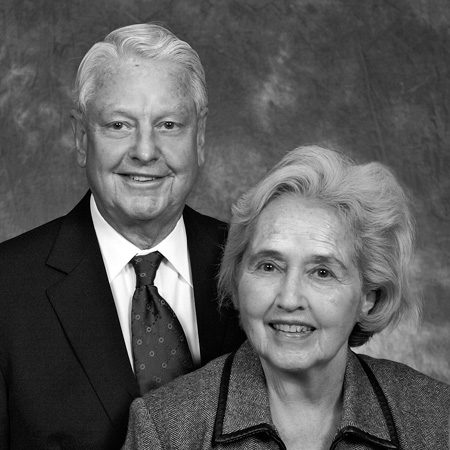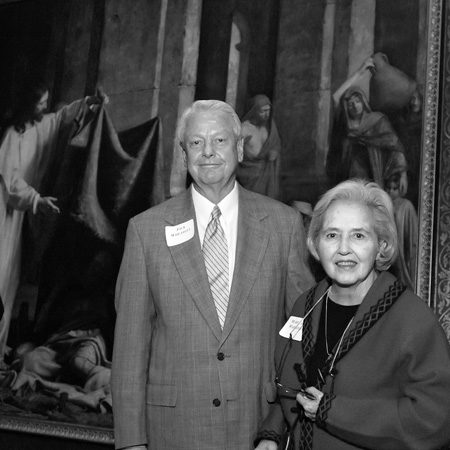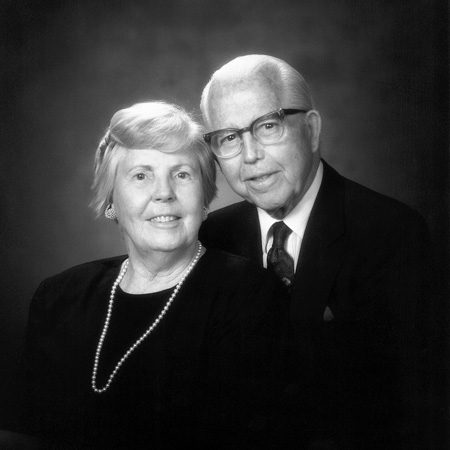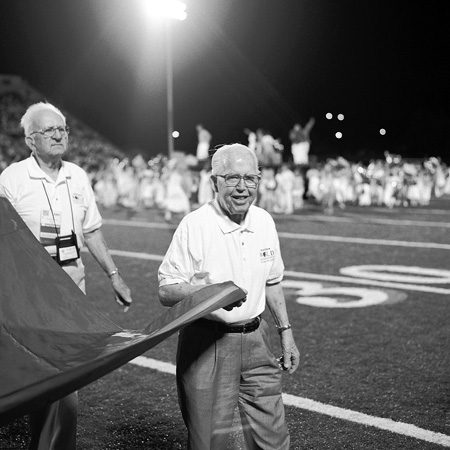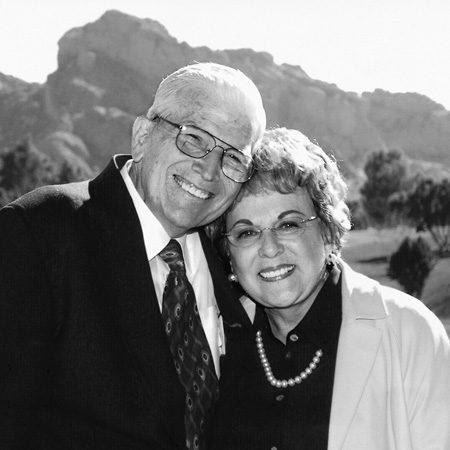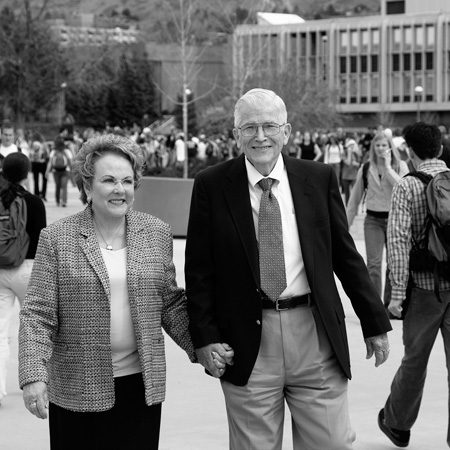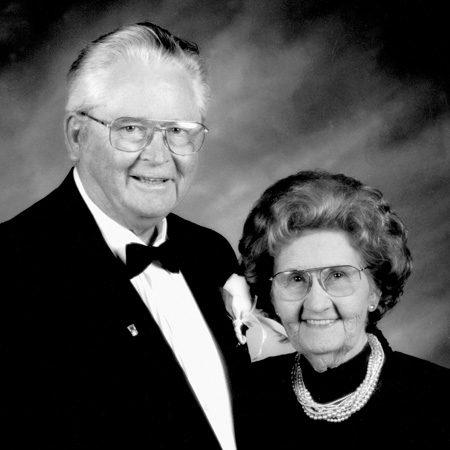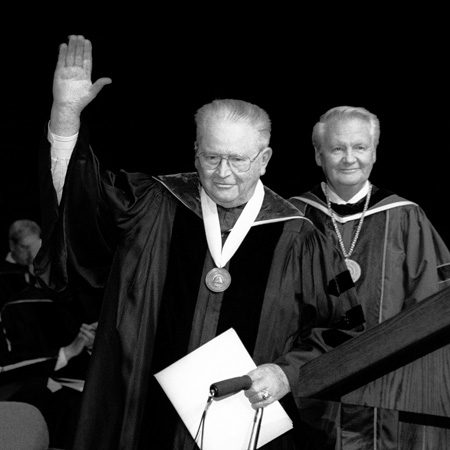From erecting the new Gordon B. Hinckley Building to supporting student scholarships, the BYU President’s Leadership Council pitches in time, energy, and money to build BYU.
You’re not likely to see Ira and Mary Lou Fulton swinging hammers on campus. Likewise, don’t expect to happen upon Jack and Mary Lois Wheatley digging holes for new trees in a BYU quad. And you won’t find centenarian Russell Clark on hands and knees applying the finishing touches to fresh concrete.
They may not wear hard hats and tool belts, but these are builders of BYU in a very real sense. Along with nearly 90 other couples and individuals, they form the BYU President’s Leadership Council (PLC), a crew that helps move plans for BYU’s future from blueprints to reality, as with the Gordon B. Hinckley Alumni and Visitors Center, where they are matching student, employee, and alumni donations. And although they help erect structures, they also build up BYU in countless other ways— from expanding supercomputing power to assembling a structure for mentored student learning to laying a foundation for athletics success.
These volunteer workers come by invitation of President Cecil O. Samuelson. With a commitment to donate at least $1 million in a five-year period, they provide a large portion of the funding for many of BYU’s top priorities. But BYU PLC members’ contributions extend beyond money to elbow grease as they devote time, energy, and influence to address campus needs. They attend regular BYU PLC meetings, serve on college volunteer councils, and recruit friends to join the team.
BYU PLC members’ reasons for pitching in on BYU projects like the Hinckley Building vary as much as their backgrounds. Businessmen and women, farmers, investors, and homebuilders, members may be drawn to BYU as alumni or parents of students. Some may be diehard Cougar fans. Nonalumni members, of which there are many, may see involvement as a way to support The Church of Jesus Christ of Latter-day Saints. Whatever their motivation, workers in this vast and varied construction crew are unified by love for BYU, belief in its mission, and desire to see students and faculty achieve.
The following five profiles of PLC members offer a glimpse at the breadth of individuals, causes, and backgrounds represented by the group.
A University to Match the Mountains
This campus should match the majesty of the mountains,” Jack Wheatley thought as he stepped onto BYU’s campus for the first time in the early 1970s.
The builder had come from California to drop off one of his children—a new student at BYU—and took the opportunity to observe the campus’ buildings and landscaping. Frankly, he wasn’t impressed. The dynamic backdrop of rugged mountains only made the utilitarian architecture, meager landscaping, and newly planted trees “the size of buggy whips” stand out more.
Wheatley was no mere armchair critic. A commercial builder, real-estate developer, and former mayor in Palo Alto, Calif., he built many learning facilities— from research laboratories at Stanford University to the Oakland Temple of the Church of Jesus Christ. He paid particular attention to the setting of his buildings, adding lakes, streams, and trees; he won a national landscaping award from President Jimmy Carter in 1977.
So when he took his concerns to Fred A. Schwendiman (’53), BYU’s newly appointed vice president over the physical plant, he knew whereof he spoke. Wheatley put forward $25,000, all he could afford at the time, and with Schwendiman he selected larger trees and made plans for improved landscaping across campus.
More than 30 years later, Jack Wheatley and his wife, Mary Lois, have given thousands of trees to campus. But trees are just the start of their contributions to BYU. The amount of time, energy, and money the Wheatleys devoted to BYU took a quantum leap in the mid-1980s, when BYU president Jeffrey R. Holland (BS ’65) told them of another campus need. BYU, he explained, lacked an art museum. This time, the need aligned with Mary Lois’ area of expertise.
A lifelong painter, Mary Lois studied portraiture at the University of Utah and in New York City, where she met Jack, then a West Point cadet. Reared in a family that valued refinement and beauty, she wove art and music into the fabric of her own family as a mother. “I think people are inspired by aesthetic things,” she says, “and it drives them on to be aware of beauty and excellence.”
With Mary Lois’ artistic sensibilities and Jack’s architectural know-how, the Wheatleys played a leading role in designing the new museum. They inspected everything from floor plans to electrical systems at a dozen art museums from Los Angeles to Paris. They stayed involved even during a mission to Portugal, and after their mission they set to work obtaining the remaining funding for the building, which was dedicated in 1993.
The Wheatleys have continued their involvement with the museum; Jack remains on its board of directors, and he and Mary Lois have recently donated funds for several new acquisitions, including Carl Bloch’s Christ Healing the Sick at Bethesda and a portrait by John Singer Sargent.
Jack’s fund-raising role at BYU deepened in the 1990s, when he was asked to help lead the Lighting the Way capital campaign—which brought $400 million to the university in six years. After the campaign the Wheatleys became part of the executive committee of the BYU President’s Leadership Council, where Jack serves as cochair, leading many of the council meetings.
These two non-BYU graduates say their enthusiasm for the university is fueled by BYU’s mission to meld a world-class education with the gospel and to teach character, leadership, honor, and ethics to all students. “The most important thing is what the students amount to,” Jack says, explaining their desires to improve BYU’s facilities. “But the environment you’re in makes a difference. We want people to recognize that this is a place that can bring you to a higher level of learning, a higher level of performance, a higher level of thinking. The quality of the buildings makes a difference. It raises the students’ vision.”
—Peter B. Gardner (BA ’98), Associate Editor
Always Looking Up
He’s really quite dapper with his shirt neatly pressed and his hair combed just right. His smile lights up his face, and the twinkle in his eyes makes you feel sure he knows something you don’t. After 105 years, no doubt he does.
Russell B. Clark was born in Montpelier, Idaho, on Nov. 19, 1900, the ninth of 11 children. He was raised on a dairy farm in nearby Georgetown by a hard-working father and an enterprising mother, who sold ice cream and buttermilk and was the unofficial baby nurse for Bear Lake County. His life has spanned decades of struggles, triumphs, and history, but for this centenarian it comes down to one thing: “Positive,” he says. “Always looking up.”
“People cannot come to know Dr. Clark without coming away with a feeling of hope, optimism, and the power of service,” says Elaine S. Sorensen Marshall, dean of BYU’s College of Nursing, a beneficiary of Clark’s philanthropy.
Clark’s positive attitude and lifetime of service began early. At age 8, young Russell was assigned to drive the horse and buggy for his mother when she went on calls to care for sick babies. Influenced by his mother’s service, Clark started medical school at the University of Utah and completed his training at Northwestern University in Chicago.
A young Dr. Clark was on call Feb. 14, 1929, when Al Capone’s gang hit Bugs Moran’s gang, killing seven men in a Chicago warehouse. Clark helped confirm the deaths, and the incident became known as the St. Valentine’s Day Massacre.
During the Great Depression, Clark often provided his services free of charge and supplied his patients with vitamins at little or no cost. When the economy improved, those patients returned his kindness, and his practice thrived.
In 1947 Clark moved to Artesia, Calif. Finding it difficult to get a post at a California hospital, he created his own post—by purchasing a small hospital that he ran for the next 20 years.
Though not a BYU alumnus, Clark has been involved with BYU for decades. In 1955 he was in Laie, Hawaii, when LDS Church President David O. McKay broke ground for the Church College of Hawaii, later named BYU–Hawaii. A few years later, Clark and his wife, Donna, moved to Hawaii temporarily to establish and run the college’s first health center. In 2005 he was back in Laie for BYU–Hawaii’s 50th anniversary celebration.
Clark also has a long history of generous contributions and service to programs on the Provo campus. Destinations for his contributions include the Gordon B. Hinckley Alumni and Visitors Center, the College of Nursing, the Joseph F. Smith Building, BYU athletics, scholarships, and BYU’s gerontology program, which has an annual conference named after Clark.
Of late, Clark has become a bit of a celebrity. Although he hung up his stethoscope about 25 years ago, he has continued to work in real estate and land development. Shortly before his 103rd birthday, Clark flew to Washington, D.C., to be named America’s Oldest Worker for 2003. He has received calls from local newspapers, CNN, and Jay Leno, and he has participated in the Huntsman World Senior Games Opening Ceremonies in St. George, Utah. And, of course, he was recently the man of the hour at the birthday bash of the century: his 105th birthday party.
Clark also continues his involvement at BYU, bringing a spirit like no other to the President’s Leadership Council, says Larry Jenson, director of principal gifts for LDS Philanthropies at BYU. “Dr. Clark has become the senior member of our leadership council—revered, respected, admired, and loved.”
Clark says he’s happy to continue to serve wherever he is asked: “It’s one of two answers: yes or no. And if it’s positive and in the right, then it’s always yes.”
—Lisa Ann Thomson (BA ’95)
Taking a Turn to Serve
Some people seem to have more hours in their day. Otherwise how do you explain a power couple like Ross and Anita Farnsworth? Between them they have served on city councils, chaired numerous community committees, volunteered for and donated to BYU fund-raising campaigns, established a homeless shelter, and created a community storytelling festival, all while running a successful real-estate-development company. Most impressively, they play the active roles of parents and grandparents to 12 children, 61 grandchildren, and 21 great-grandchildren.
“Somebody’s got to do it,” says Anita (’60) with a laugh. “When we’re so blessed, we should certainly be willing to take our turn and step up and do it.”
She’s not being modest. Anita and Ross Farnsworth simply believe giving of their time and means to righteous causes is the obvious way to live their lives.
“From day one in their marriage, service has really been the hallmark of their lives,” says M. McClain Bybee (’68), managing director of LDS Philanthropies.
Lifelong residents of Mesa, Ariz., the Farnsworths were surprised when more than 20 years ago they received a phone call informing them Ross had been elected to BYU’s Alumni Board. He mentioned to the person on the line that he had only attended BYU for one quarter, but he was assured a quarter was good enough. So Ross agreed to serve, and he and Anita, who attended BYU for a year, have been doing so with gusto ever since.
The Farnsworths each served on the Alumni Board, working specifically with the Aspen Grove Family Camp. They later served on other BYU committees, and Anita filled a leadership role during the Lighting the Way capital campaign. Today they are on the BYU President’s Leadership Council and the Friends of the Harold B. Lee Library Board, of which Anita is the chair.
“When they asked me to be the chair, I said, ‘I think it’s because I’m the oldest one here and we all have to have a turn, and I’ve got to have my turn before I die,’” Anita quips.
But the Farnsworths are serious about their commitment to the library and to literacy. They have generously supported the library, and the Farnsworth Juvenile Literature Library is named in their honor.
“I give books to all of my grandchildren every year,” Anita says. “That’s their Christmas present from me.” She attends BYU’s annual Books for Young Readers conference whenever she can, and she and five of her daughters started a storytelling festival in Mesa, patterned after the long-standing Timpanogos Storytelling Festival.
The Farnsworths have also contributed to BYU’s athletics facilities, Aspen Grove, the Center for Entrepreneurship, the Young Ambassadors, and most recently to the Gordon B. Hinckley Alumni and Visitors Center. They remain committed to the university and appreciate what it has meant for their family. Eleven of their 12 children attended BYU. “If we’re going to let them out of our house, we want them in the best place they can be,” Anita says. “We really feel like it’s the Lord’s university and it’s spreading Zion on the earth.”
“The Farnsworths are just genuinely good-hearted people with a very, very genuine, sincere approach,” says Bryan P. Carpenter (BS ’80), a major-gifts manager for LDS Philanthropies. “They love BYU.”
The Farnsworths say they get more than they give. “The time we give is more blessing to us than it is either a service or sacrifice,” Anita says.
—Lisa Ann Thomson (BA ’95)
Overflowing Generosity
Becoming a billionaire means zilch to me because you can’t take it with you,” says philanthropist Ira A. Fulton. “Now, to give away a billion dollars—that’s important.”
The Arizona native and his wife, Mary Lou, have made steady progress toward that ideal. They have appeared on more than one list of America’s top philanthropists— in the company of familiar names like Bill Gates, Warren Buffet, Charles Schwab, and Oprah Winfrey. And BYU has been the beneficiary of much of their overflowing generosity.
The Fultons’ relationship with BYU began in 1999 during the Lighting the Way capital campaign. The campaign was approaching a successful conclusion when President Gordon B. Hinckley challenged donors to do a little more—about $20 million more. After the meeting, Fulton approached the prophet and said, “You’ve got your additional 20 million.”
It would take the rest of the page to list the myriad donations the Fultons have since made to BYU and BYU–Hawaii— supercomputers, endowed chairs, and entire science labs, to name a few. And then there would be no room to list the contributions they have made to Arizona State University, to cancer research, to political interests, and to community initiatives, not to mention private kindnesses to family and friends.
In the Nov. 28, 2005, issue of BusinessWeek magazine, Ira and Mary Lou were named among the 50 most generous U.S. philanthropists. According to the report, they have given away $160 million, 38 percent of their net worth. However, the article was published just before the Fultons announced a $100 million gift to ASU, where they both attended college.
“I’m educating a lot of great men and women who will go out and be our future CEOs and CFOs, and within the Church, our bishops, our General Authorities, our mission presidents,” Ira told BusinessWeek. “Like I told the prophet, President Hinckley: ‘I’m going to let you spiritually save their souls, and I’m going to educate their souls.’”
The Fultons hope their generosity serves as an example to others to be as unabashedly generous as they have been. But Ira is not above heavy-handed encouragement. “You wouldn’t want to have a lot of money because you’d have to say no to me a lot of times. . . . I’m very much a strong-arm guy,” Ira toldBusinessWeek. But he strong-arms his associates in the most accommodating ways, he added. “They’ll say, ‘Ira, we can’t afford it,’ and I’ll say, ‘Well, I’ll loan you the money till you can pay me back.’”
Ira credits his generosity to his mother’s example. She ran a hamburger stand close to their home in Tempe, Ariz., and Ira often saw his mother give away a meal to someone who was hungry. It left a lasting impression, and, as Ira found success in a retail clothing store chain and later in residential construction, he has emulated his mother’s example. Today, he says he can easily resist offers to get in on an investment, but he can hardly say no to someone in need.
Ira learned another lesson from his father: “When I was 12, my father stood me in front of a mirror and told me, ‘There’s your competition. Don’t compare yourself with others; just compare yourself with you.’”
Perhaps that’s part of his motivation— to outdo himself with large donations to BYU and other causes. But Ira admits it’s also kind of fun to see his fortunes go to good use while he has the chance.
“People are always leaving it to their kids or trusts or to foundations,” he told the Chronicle of Philanthropy, which featured the Fultons as the ninth most generous donors in America for 2005. “But I found out it would be more fun to give our money away while we’re still alive so we can see what happens with it.”
—Lisa Ann Thomson (BA ’95)
A Hand Up for Those in Need
In 1957 Shirley Hamblin suddenly found herself, at 25, a single mother of five children. Her ex-husband had left the country, and she had no means to support her family. She eventually landed a job as a bus girl at the Harman’s Café on North Temple in Salt Lake City.
One day soon after she began working, a man showed up at the restaurant and said hello. “I didn’t know who he was,” Hamblin recalls. “I was shocked when I found out it was Pete Harman, because he was so casual and kind.” Harman, who owned the restaurant and two others, learned of Hamblin’s circumstances and, with Thanksgiving approaching, made sure she was paid a little extra. Harman repeated the gesture until she was back on her feet.
“He was so good to us,” says Hamblin, now retired after working for the company for 43 years, eventually becoming a store manager and then an area consultant for Harman Management Corp. “He wanted to make sure I could make a living for my children.”
If Leon W. “Pete” and Arline Harman have become known for helping the Shirley Hamblins of the world, Harman says it is because he knows what it is like to be in great need—and to receive great kindness. Losing his mother just days after his birth and his father five years later, Pete, along with his many siblings, was taken in by his widowed aunt Caroline Hemenway Harman, who would rear 14 children on her Salt Lake Valley farm. “She was all service and no quit,” Harman remembers. “She was always out helping.”
So in the early 1980s, when BYU offi- cials considered naming the new continuing- education building after major donor Pete Harman, he flatly refused. If they wanted to honor someone, he insisted, it ought to be his aunt Carrie.
Pete and Arline’s success began in 1940 when, recently married, they made their first foray into the restaurant business, buying a run-down root beer stand for $700 and calling it the Do Drop In. During ensuing years, it grew into Harman’s Café. In 1951 Harman attended a convention in Chicago, where he met a charismatic goateed man. Dubbed a colonel by the governor of Kentucky for contributions to state cuisine, Harland Sanders had experimented with frying chicken in a pressure cooker. The next year Sanders dropped by the Harmans’ while traveling through Utah. Refusing his hosts’ offer of a meal, he instead proposed to fry up some chicken.
It took only a few bites for Harman to know he wanted the chicken on his restaurant’s menu. With a handshake, Sanders agreed to share his secret recipe, for which Harman would pay a nickel for every chicken sold—making the Harmans the first franchisees of what became known as Kentucky Fried Chicken. Fifty-four years later, the Harman System has more than 300 restaurants in Utah, Colorado, Washington, and California.
Though famed in the industry for his innovations, Harman feels most proud of ways his restaurants have fostered growth among their restaurant employees, particularly women like Hamblin. Early on Harman created a policy of sharing the company’s annual profits with employees, and he has encouraged store managers to become part owners of their stores. To Harman, treating employees well makes good business sense. “Employees want to work for a fair employer,” he says. “If you give them a halfway decent break, they’ll go a long ways beyond the capacity they think they’ve got.”
This philosophy extends to the Harmans’ philanthropy to various organizations, particularly BYU. Since 1983 the Harmans’ scholarship fund has helped students afford an education, becoming BYU’s largest need-based scholarship from a private donor. Last year alone, the fund assisted 90 students.
Having received a hand up in his own time of struggle, Harman says it is only natural that he should pass on the gesture, reaching out with encouragement and financial help to those in need. “Money,” as he likes to say, “is only good for what you can do with it.”
—Peter B. Gardner (BA ’98), Associate Editor
BYU President’s Leadership Council Executive Committee
Meeting on a more frequent basis than the larger group, a core of the BYU President’s Leadership Council helps direct the council’s activities. This executive committee includes the 12 members listed here.
Alan C. and Karen Jackman (’81) Ashton
Orem, Utah (currently president, Canada Toronto West Mission)
Vocation: BYU professor, WordPerfect cofounder, Thanksgiving Point developer, real estate
Giving interests: FARMS, BYUTV, president’s priorities, Gordon B. Hinckley Building
H. Brent (Bonnie Jean) Beesley (BA ’69)
Salt Lake City, Utah
Vocation: Heritage Savings Bank chairman and CEO, Southern Virginia College trustee
Giving interests: Athletics facilities and scholarships, Joseph F. Smith Building, Marriott School, Gordon B. Hinckley Building
Stephen R. (DRE ’76) and Sandra R. Merrill (BS ’60) Covey
Provo, Utah
Vocation: BYU professor and administrator, author of The Seven Habits of Highly Effective People and other books, vice chairman of FranklinCovey
Giving interests: Joseph F. Smith Building, athletics, Marriott School, Gordon B. Hinckley Building
Arlen B. (BS ’62) and Derrel R. Crouch
Sandy, Utah
Vocation: Private business ventures, former CEO of FranklinCovey
Giving interests: Athletics facilities, president’s priorities, Gordon B. Hinckley Building
Larry H. and Gail S. Miller
Salt Lake City, Utah
Vocation: Auto dealerships, Delta Center and Utah Jazz owner, real estate
Giving interests: Joseph Smith Papers Project, Miller Park (baseball and softball complex), Gordon B. Hinckley Building
Mark H. and Laura B. Willes
Provo, Utah
Vocation: CEO of Times Mirror, vice chairman of General Mills
Giving interests: Scholarships, president’s priorities, Marriott School, Gordon B. Hinckley Building
Richard L. and Cindy M. Thawley
Lodi, Calif.
Vocation: Business, real estate Giving interests: BYU Broadcasting, Harold B. Lee Library, College of Humanities, Gordon B. Hinckley Building
Jack R. and Mary Lois S. Wheatley
Carmel, Calif.
Vocation: Commercial construction, real estate, former mayor of Palo Alto, Calif.
Giving interests: Museum of Art, campus landscaping, president’s priorities, Scholarships, Gordon B. Hinckley Building
Ira A. and Mary Lou Fulton
Phoenix, Ariz.
Vocation: Retail, residential construction
Giving interests: Ira A. Fulton College of Engineering and Technology, supercomputers, buildings, research centers, scholarship programs, Gordon B. Hinckley Building
Rex G. (’62) and Ruth G. Methvin (BA ’60) Maughan
Scottsdale, Ariz.
Vocation: Founder and CEO of Forever Living Products
Giving interests: BYUTV, Harold B. Lee Library, Gordon B. Hinckley Building
Kevin B. (BA ’83) and Debra A. Skinner (’75) Rollins
Austin, Texas
Vocation: President and CEO of Dell
Giving interests: Joseph F. Smith Building, athletics facilities, Kevin and Debra Rollins Center for eBusiness, Gordon B. Hinckley Building
Robert C. (’74) and Lynette Nielsen (’74) Gay
Ridgefield, Conn. (currently president, Ghana Accra Mission)
Vocation: Management consulting, Bain Capital, entrepreneurial activities
Giving interests: Joseph F. Smith Building, FARMS, Center for Economic Self- Reliance, Gordon B. Hinckley Building
FEEDBACK: Send comments on this article to magazine@byu.edu.







